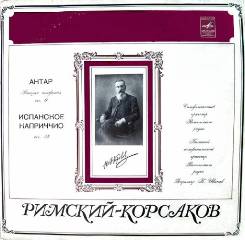Nikolai Rimski-Korsakov: Antar – Capriccio Espagnol (1973)
Nikolai Rimski-Korsakov: Antar – Capriccio Espagnol (1973)

Symphony No. 2, Op. 9: Antar 1.The Beautiful Desert Of Sham 2.The Pleasure Of Vengeance 3.The Pleasure Of Power 4.The Pleasure Of Love 5. Capriccio Espagnol, Op. 34 Moscow Radio Symphony Orchestra Konstantin Ivanov – conductor
Nikolay Rimsky-Korsakov had a work ethic that bordered on the obsessive, and when inspiration failed him, he would often busy himself by tidying up works from his youth. This habit accounts for the proliferation of versions of Antar. This work was composed between January and August 1868, and premiered in March of the next year. After a few alterations, it was published in 1880 as his Second Symphony. However, in the "new edition" of 1903, which was dated 1897, "Antar" was substantially revised and called a symphonic suite, with the words Second Symphony in a parenthetical subtitle. In 1913, a final version of Antar came out, called simply a "Symphonic Suite," as Rimsky-Korsakov had decided that Antar was "a poem, suite, fairy tale, story, anything you like, but not a symphony." The final version changes the key of the second movement and has more refined and detailed orchestration. However, the earlier version may best preserve the freshness of Rimsky-Korsakov's response to the myth of Antar, a great warrior from Arabian literature.
Rimsky-Korsakov's program opens with Antar wandering the ruins of the ancient desert city of Palmyra. Rimsky-Korsakov portrays the desert with grim, bare woodwind chords and elusive, chromatic fragments of melody sweeping over them. Antar's theme enters on the strings, in a lush, resigned harmonization, as he has come to the desert to renounce humanity. Suddenly, a beautiful gazelle appears, which Antar chases. A huge black bird swoops down on the gazelle, but Antar repels it with his lance. He then falls asleep, and in his dream he meets the Queen of Palmyra, Gul Nazar, who had taken the form of the gazelle that Antar saved. The Queen is represented by a lovely, winding wind theme. Gul Nazar promises Antar the three joys of life in exchange for his good deed; as Antar contemplates his newfound good fortune, he wakes up to the strains of the harp and the Gul Nazar theme, amid the ruins of Palmyra. So ends the first movement. The second and third movements are devoted to depicting the joys of revenge and power, respectively. Rimsky-Korsakov uses nervous tremolos in the strings and puts the Antar theme in defiant brass to suggest revenge, while the Antar theme is played sweetly on the strings and in fanfares by the brass to depict power. In the last movement, Antar is allowed to experience the ultimate joy, the love of Gul Nazar. He insists that she kill him when she feels his passion cooling; this she does, and Antar dies in her arms. This movement features some of Rimsky-Korsakov's finest orchestration, including transcendently poignant blends in the woodwinds which depict the two lovers as their passion swells and fades, ultimately ascending to heaven on a swirling harp and lying to rest with a few final chords. Anyone who enjoys Scheherazade should try Antar next, as this symphony is almost as inspired as that peak of Rimsky-Korsakov's symphonic oeuvre. --- Andrew Lindemann Malone, Rovi
A kaleidoscope is an instrument comprising mirrors enclosing bits of coloured glass which produces, by the simplest of means, the most marvellously coloured patterns - a close analogy to Rimsky-Korsakov, except that anyone can work a kaleidoscope. Rimsky-Korsakov's skill for shaking up orchestral instruments is arguably still unique.
It wasn't always so. Originally a Naval Officer, perhaps explaining his taste for the exotic, he started composing as an untrained amateur. In 1867, his “ultra-modernism”(?) earned him the Professorship of Practical Composition at St. Petersburg Conservatoire. But, as he said, he “couldn't harmonise a chorale, had never done any exercises in counterpoint, had no idea of strict fugue, and moreover couldn't name the chords and intervals.” His knowledge of instrumental techniques was scant (and obsolete!). He coped by teaching himself one step ahead of his students, thereby becoming at once a great teacher and a model pupil.
It must have been Sadko, A Musical Picture Op. 5, a disgracefully neglected masterpiece of orchestral inventiveness, that prompted this crucial recognition, setting him on a course (N.B. Naval metaphor!) which led in 1887 to the Capriccio Espagnol, that most famous of ersatz-Spanish music (indeed, many find it more idiomatic than Falla). You could just relax and bathe in Rimsky's intoxicating brew (I usually do!). Otherwise, read on:
The brief Alborada, or “morning dance”, bursts out fit to wake the dead, never mind the sleeping, alternating two lushly-scored fortissimi with two much sparer renditions, the second melting away into silence.
The set of Variazioni on a gorgeously romantic tune form a beautiful if relatively conventional interlude.
The Alborada returns dressed in new clothes, principally the staggeringly simple device of more or less swapping the roles of the solo clarinet and violin. A sudden crescendo heralds ...
Scena e Canto Gitano: balancing the Variazioni, the Scene is a group of largely cadential variations, each solo cadenza sporting a different percussion halo, on the theme of the subsequent Gypsy Song.
Mid-flight (about where Dean drags Torville like a matador's cape!), the Fandango stamps in emphatically, triggering an astonishing sequence where Rimsky repeatedly establishes one sonority, then overlays it with another in a veritable counterpoint of colour. The Gypsy Song makes a brief reappearance just before the coda, the Alborada resurging in a dizzying whirl, whose dull cadence might spark a small pang of disappointment, if we weren't too dizzy to notice. --- Paul Serotsky, musicweb-international.com
download: uploaded yandex 4shared mediafire solidfiles mega filecloudio nornar anonfiles ziddu
Zmieniony (Piątek, 11 Kwiecień 2014 16:14)








